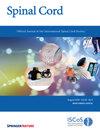Development of the tele-neurological assessment for the level, severity, and completeness of spinal cord injury (TNASCI): reliability and validity
IF 2.2
4区 医学
Q3 CLINICAL NEUROLOGY
引用次数: 0
Abstract
Psychometric study. To introduce a novel, simple, tele-assessment tool designed to report the level and severity of spinal cord injury (SCI) and to assess its reliability and validity. Two academic-affiliated rehabilitation facilities in Thailand. The Tele-Neurological Assessment for the level, severity, and completeness of Spinal Cord Injury (TNASCI) was designed to assess the SCI level and severity according to the International Standards for Neurological Classification of Spinal Cord Injury (ISNCSCI) using telecommunication. This study comprised three phases: (1) the development process involving three experts using the Delphi method, (2) a face validity examination of each TNASCI item’s comprehension and suitability, and (3) an evaluation of the concurrent validity, intra-rater reliability, and inter-rater reliability using data from 40 participants with chronic SCI (>12 months post-injury). The Thai version of TNASCI, was developed to contain four sections, including sensory, motor, anorectal function, and summary sections to determine the SCI level and severity grade. The assessment tool exhibited good face validity. When compared with the ISNCSCI, the TNASCI showed good to excellent inter-rater and intra-rater reliability, with an intraclass correlation coefficient (ICC) (2,1) of 0.791–0.941 and an ICC (3,1) of 0.785–1.00, and good to excellent validity in almost all sections except for the sensory-related components (r = 0.764–0.986). Our TNASCI tool, which was assessed by trained clinicians, demonstrated acceptable inter-rater and intra-rater reliability, face validity, and concurrent validity. It serves as an alternative tool to evaluate the SCI level and severity predominantly in people with chronic, motor-complete SCI who cannot be evaluated using the hands-on ISNCSCI in person. However, this study is an initial step in validating a novel tele-assessment tool, with future studies needed to confirm its utility in other conditions and settings.脊髓损伤水平、严重程度和完整性的远程神经学评估(TNASCI)的发展:信度和效度。
研究设计:心理测量学研究。目的:介绍一种新颖、简单的远程评估工具,用于报告脊髓损伤的程度和严重程度,并评估其信度和效度。环境:泰国的两个学术附属康复设施。方法:根据国际脊髓损伤神经学分类标准(ISNCSCI),设计脊髓损伤水平、严重程度和完整性远程神经学评估(TNASCI),采用电信方式评估脊髓损伤的水平和严重程度。本研究包括三个阶段:(1)由三位专家采用德尔菲法进行开发;(2)对TNASCI各条目的理解和适宜性进行面效度检验;(3)使用40名慢性脊髓损伤患者(损伤后12个月)的数据对TNASCI的并发效度、评核内信度和评核间信度进行评估。结果:泰国版的TNASCI包含四个切片,包括感觉切片、运动切片、肛肠功能切片和总结切片,以确定SCI水平和严重程度等级。评估工具具有良好的面效度。与ISNCSCI相比,TNASCI在评分者间和评分者内均表现出良好至优异的信度,类内相关系数(ICC)(2,1)为0.791-0.941,类内相关系数(ICC)(3,1)为0.785-1.00,除感觉相关成分(r = 0.764-0.986)外,几乎所有部分都具有良好至优异的效度。结论:我们的TNASCI工具经过训练有素的临床医生的评估,显示出可接受的评估者间和评估者内信度、面效度和并发效度。它作为一种替代工具,主要用于慢性、运动完全性SCI患者,这些患者无法使用亲自动手的ISNCSCI进行评估。然而,这项研究是验证一种新型远程评估工具的第一步,未来的研究需要确认其在其他条件和环境中的效用。
本文章由计算机程序翻译,如有差异,请以英文原文为准。
求助全文
约1分钟内获得全文
求助全文
来源期刊

Spinal cord
医学-临床神经学
CiteScore
4.50
自引率
9.10%
发文量
142
审稿时长
2 months
期刊介绍:
Spinal Cord is a specialised, international journal that has been publishing spinal cord related manuscripts since 1963. It appears monthly, online and in print, and accepts contributions on spinal cord anatomy, physiology, management of injury and disease, and the quality of life and life circumstances of people with a spinal cord injury. Spinal Cord is multi-disciplinary and publishes contributions across the entire spectrum of research ranging from basic science to applied clinical research. It focuses on high quality original research, systematic reviews and narrative reviews.
Spinal Cord''s sister journal Spinal Cord Series and Cases: Clinical Management in Spinal Cord Disorders publishes high quality case reports, small case series, pilot and retrospective studies perspectives, Pulse survey articles, Point-couterpoint articles, correspondences and book reviews. It specialises in material that addresses all aspects of life for persons with spinal cord injuries or disorders. For more information, please see the aims and scope of Spinal Cord Series and Cases.
 求助内容:
求助内容: 应助结果提醒方式:
应助结果提醒方式:


